
In the first two articles of our three-part series on interesting ways to enjoy Kyoto based on my recent visit to the popular tourist city, I have already written about an attractive place to stay and a fascinating historic site to visit. In the third and final article of the series, I thought I would introduce a restaurant where you can have a truly unique dining experience, because of course, no trip to Kyoto would be complete without tasting the numerous culinary delights the city has to offer. The restaurant I visited was Hyotei, a famous establishment with a long history that specializes in Japanese kaiseki cuisine. And what is so unique about dining there? Well, for starters, you can have a breakfast rice porridge dish (asagayu) that costs 4,500 yen (US$45)!
Hyotei is located in a quiet area of Kyoto near the temple of Nanzenji, and its history began approximately 400 years ago as a tea house that catered to travelers making pilgrimages to the temple. Now, it is a well-known, premier dining establishment that has received three-stars in the Michelin Guide for the Kanasi area (which incorporates cities such as Kyoto, Osaka, Nara and Kobe) for four consecutive years. In fact, the Kyoto-style cuisine prepared by the restaurant’s head chef, Eiichi Takahashi, was just this year designated an Intangible Cultural Property (mukei bunkazai) by the prefecture of Kyoto.
Now, while I admit that $45 for rice porridge certainly boggles the mind, it isn’t every day that I have the opportunity to eat at a three-star Michelin restaurant in Kyoto, so I made up my mind and made reservations for breakfast at Hyotei. Besides, having dinner at the famous ryotei, as old-fashioned up-scale Japanese restaurants are often called, would be much more prohibitively costly, so in a way, having the rice porridge breakfast course probably made sense (or so I told myself).
▼The front entrance and exterior of Hyotei — not surprisingly, the restaurant has a very traditional appearance
▼ You can look out into a lovely little garden from the seats inside
The highly anticipated breakfast course started with a refreshing drink of hot plum and seaweed tea (ume-konbu cha).
This was followed by carefully arranged appetizers on both a tray and in a very unique, three-layered ceramic container. On the tray there was sweet-potato flavored with a sweet syrupy sauce, small pieces of sushi with a snapper-like fish, some small fish cooked in a sweet soy-sauce based sauce and the famous Hyotei boiled eggs. The Hyotei eggs are apparently a house specialty that have been served at the restaurant for over a century, and the way it is prepared so that the egg white is fully cooked while the yolk is kept at just the right softness is a trade secret.
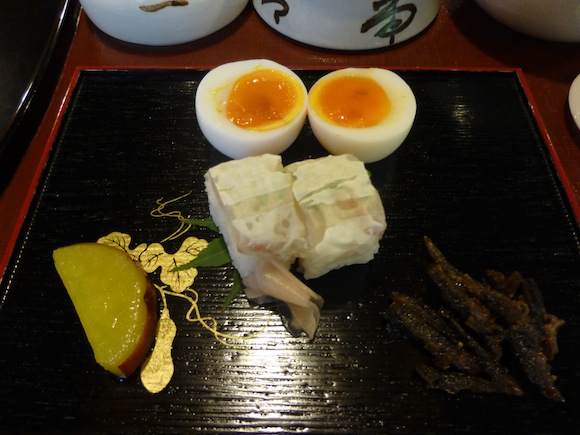
Now, on to the three-layered container. Once you open and unstack the three layers, you have three separate small bowls each with a different light dish.
One of the bowls contained a cooked sweet plum, another contained pieces of grilled salmon with grated Japanese radish and mozuku seaweed seeped in a tasty soy-sauce based sauce.
The third bowl contained octopus, pumpkin, green beans and fried tofu simmered in a slightly sweet traditional Japanese-style sauce. This was all quite tasty, but it could make you a bit full even before the rice porridge. (Well, you can always skip lunch, right?)
They also served a light, clear soup with tofu and nori seaweed that was refreshing and helped to cleanse the palate before moving on to the actual rice porridge.
The famous Hyotei porridge I’d been waiting to taste arrived on a simple-looking tray along with a bowl to eat the porridge from, and also a container of a special sauce that you pour on the porridge as flavoring.
The steaming rice porridge certainly looked appealing from the moment I opened the lid. The porridge itself isn’t flavored, since it is cooked to be eaten along with the sauce.
There were also pickled cucumbers, radish and whitebait fish to add flavor to the porridge.
I scooped some of the porridge into the rice bowl, topped it with some pickled radish and whitebait …
… and poured some of the sauce over the porridge. The sauce apparently is created with stock made from konbu seaweed and dried bonito flakes, which is then combined with soy sauce and thickened with starch.
And how did the porridge taste? It was simple but absolute culinary refinement and a blissful way to start the day. The sauce was not too rich and added just the right amount of a slightly sweet taste to the plain rice. While I was eating, I couldn’t help thinking what a perfect meal this would be for when you were suffering from a hangover or any other excesses of a late night out. But the next moment I was thinking, no, you wouldn’t want to have such a delicate, gentle dish when you weren’t in a condition to fully appreciate the subtle flavors.
So, I’m happy to be able to say that Hyotei’s porridge didn’t disappoint, and I left the restaurant feeling very satisfied. Hyotei actually has a main building and an annex, and I had my breakfast at the annex, where the breakfast porridge is served all-year-round. In the main restaurant, the breakfast porridge, priced at about $60 and served with an extra dish of grilled ayu fish in addition to the course described here, is available during July and August, and a special quail rice porridge (uzura-gayu) roughly costing an amazing $120 is served from December to mid-March.
For those of you who are looking to eat something slightly more meaty than rice porridge, there are always numerous excellent sukiyaki restaurants that you can choose from in Kyoto. Some of them, like the restaurant Komaitei I went to, operate during the summer months on an open terrace overlooking the Kamo River, which in itself makes for a particularly delightful experience.
▼ You have a very nice view of the Kamo River from the restaurant terrace
▼ Utterly beautiful beef served at Komaitei
▼ The sukiyaki is also cooked with vegetables like leeks and onions as well as other ingredients such as tofu and shirataki (glass noodles made from devil’s tongue starch)
▼ The beef is cooked first …
▼ … and then all the other ingredients are added
▼ Dip in the raw egg and enjoy!
Or, if sukiyaki is too heavy for you, there are many restaurants in Kyoto that offer lovely tofu and yuba (the creamy film that forms on the surface of heated soy milk) dishes, like the restaurant Nishida I had lunch at, located right next to the famous Ginkakuji Temple.
▼ A cold dish of noodles and yuba served on ice — wonderful in hot weather
▼ Yuba sashimi — the texture is soft, but slightly chewier than tofu
▼ Fried yuba with cream cheese filling — an unusual but unexpectedly tasty combination
And of course, all this dining is just fine, but you have to do some shopping too while you’re in Kyoto, right? A spot you might visit is the Nishiki Market in central Kyoto where you can find a wide variety of foods and other items for sale. Here are just some examples of products on sale at the market.
▼ Pickled vegetables made in Kyoto are popular not only locally but throughout Japan.
▼ Square rice crackers being sold in a variety of flavors including green tea, red bean, Japanese chili powder and mayonnaise
▼ Fu (wheat gluten) sold at a specialty store in various flavors such as pumpkin, basil, sesame and bacon
▼ Colorful Kyoto-style confectionaries, known as kyo-gashi
▼ And my favorite find — fried chocolate! Yes, it’s actual chocolate fried in a batter of bread crumbs, and these could be seriously addictive
And this last item isn’t something that I saw at the Nishiki Market, but if you’re looking for a gift for a little one, how about a traditional jinbei summer-wear like the one below? Now, just tell me your kid (or grandkid or niece or nephew) isn’t going to look devastatingly cute in one of those!
Well, that brings us to the end of our three-part series on Kyoto. I hope you enjoyed the stories and found something of interest in them. Again, though, there really is so much to do and see and eat in Kyoto, the options are endless, and it’s hard to go wrong with a visit to any of the notable temples, shrines or gardens in the city.
And so, as we bid the fair city of Kyoto farewell, we wish all of you a safe and pleasant trip to Kyoto or any other destination you may be traveling to in the future. Oh, and if you ever come to Kyoto and visit any of the places mentioned in these articles after reading them, do let us know by all means. We would sure be happy to hear about it!
Reference: Hyotei website
All photos: RocketNews24







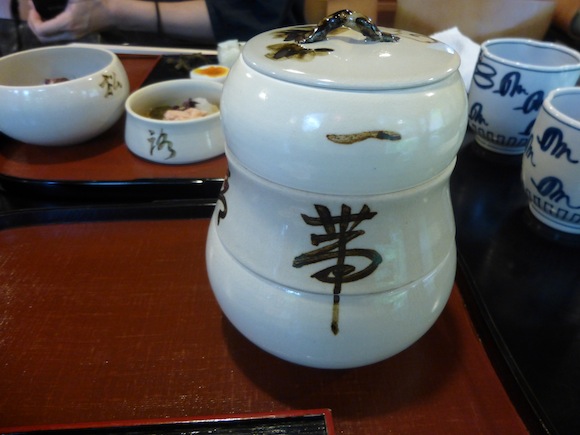


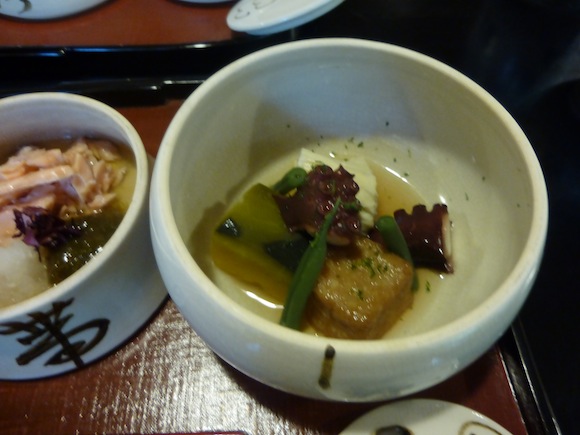



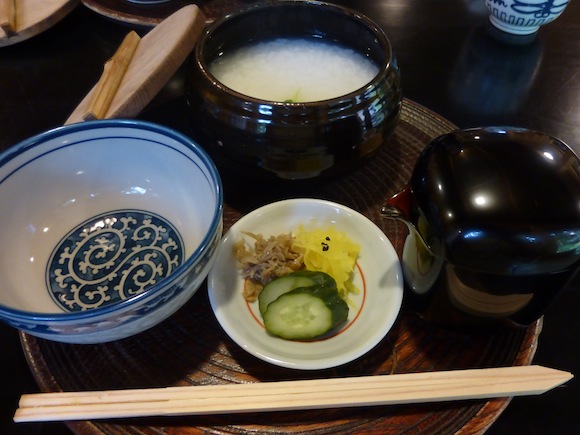







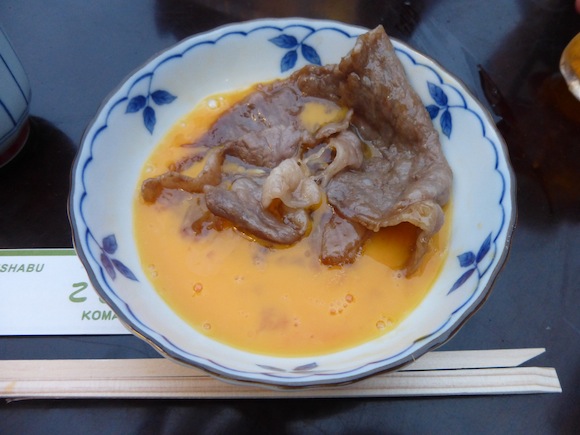












 Can Kyoto supermarket takeout let you enjoy the local cuisine without fancy restaurant prices?
Can Kyoto supermarket takeout let you enjoy the local cuisine without fancy restaurant prices? All-you-can-eat oboro tofu restaurant in Kyoto is a guilt-free experience
All-you-can-eat oboro tofu restaurant in Kyoto is a guilt-free experience Celebrating washoku and rice — an evening with master chefs and sushi roll creators (Part 1)
Celebrating washoku and rice — an evening with master chefs and sushi roll creators (Part 1) Former sushi chef serves onigiri rice balls for breakfast at new morning restaurant in Japan
Former sushi chef serves onigiri rice balls for breakfast at new morning restaurant in Japan The top 30 foods that go best with white rice, according to Japanese netizens
The top 30 foods that go best with white rice, according to Japanese netizens Ramen restaurant’s English menu prices are nearly double its Japanese ones, denies discriminating
Ramen restaurant’s English menu prices are nearly double its Japanese ones, denies discriminating Starbucks Japan releases new Frappuccino and latte for Valentine’s Day
Starbucks Japan releases new Frappuccino and latte for Valentine’s Day Is your girlfriend a cat, dog, gorilla or penguin type? Take this Twitter comic test to find out!
Is your girlfriend a cat, dog, gorilla or penguin type? Take this Twitter comic test to find out! Five tips for hosting a college-age Japanese student in your country
Five tips for hosting a college-age Japanese student in your country 7-Eleven Japan has a hack for creating insanely delicious potato chip rice meals
7-Eleven Japan has a hack for creating insanely delicious potato chip rice meals Should you drive through a red traffic light like this in Japan? Confusing road rule explained
Should you drive through a red traffic light like this in Japan? Confusing road rule explained Nearly one in ten young adults living in Japan isn’t ethnically Japanese, statistics show
Nearly one in ten young adults living in Japan isn’t ethnically Japanese, statistics show Band-aid lifehack: Japanese Twitter blows the Internet’s mind with new way to fasten bandages
Band-aid lifehack: Japanese Twitter blows the Internet’s mind with new way to fasten bandages What’s inside Starbucks Japan’s fukubukuro lucky bag for 2026?
What’s inside Starbucks Japan’s fukubukuro lucky bag for 2026? Japanese government wants to acquire original anime and manga art for creation of national archive
Japanese government wants to acquire original anime and manga art for creation of national archive 10 times to avoid traveling in Japan in 2026
10 times to avoid traveling in Japan in 2026 Our 52-year-old pole dancing reporter shares his tips for achieving your New Year’s exercise goal
Our 52-year-old pole dancing reporter shares his tips for achieving your New Year’s exercise goal Japanese beef bowl chain Sukiya’s 2026 Smile Box lucky bag basically pays for itself
Japanese beef bowl chain Sukiya’s 2026 Smile Box lucky bag basically pays for itself Top Japanese cosplayer Enako returns to Comiket after 6 years, creates mayhem with admirers
Top Japanese cosplayer Enako returns to Comiket after 6 years, creates mayhem with admirers Umamusume anime girl plushie recalled for having parts she absolutely should not have【Pics】
Umamusume anime girl plushie recalled for having parts she absolutely should not have【Pics】 We ate sushi made from Japan’s most expensive tuna ever【Taste test】
We ate sushi made from Japan’s most expensive tuna ever【Taste test】 Princess Mononoke magnets return just in time to treat yourself to awesome anime decorations
Princess Mononoke magnets return just in time to treat yourself to awesome anime decorations Starbucks Japan ready to get Year of the Horse started with adorable drinkware and plushies【Pics】
Starbucks Japan ready to get Year of the Horse started with adorable drinkware and plushies【Pics】 7-Eleven Japan starts new temporary luggage storage service in over 300 branches
7-Eleven Japan starts new temporary luggage storage service in over 300 branches Disillusionment at Tsukiji’s tourist-target prices led us to a great ramen restaurant in Tokyo
Disillusionment at Tsukiji’s tourist-target prices led us to a great ramen restaurant in Tokyo Starbucks teams up with 166-year-old Kyoto doll maker for Year of the Horse decorations【Photos】
Starbucks teams up with 166-year-old Kyoto doll maker for Year of the Horse decorations【Photos】 Tokyo’s Tsukiji sushi neighborhood asks tour groups to stay away for the rest of the month
Tokyo’s Tsukiji sushi neighborhood asks tour groups to stay away for the rest of the month Japan may add Japanese language proficiency, lifestyle classes to permanent foreign resident requirements
Japan may add Japanese language proficiency, lifestyle classes to permanent foreign resident requirements Lacquerware supplier to emperor of Japan and Pokémon team up for new tableware
Lacquerware supplier to emperor of Japan and Pokémon team up for new tableware Starbucks Japan releases new zodiac chilled cup drink for 2026
Starbucks Japan releases new zodiac chilled cup drink for 2026 Survey asks foreign tourists what bothered them in Japan, more than half gave same answer
Survey asks foreign tourists what bothered them in Japan, more than half gave same answer Japan’s human washing machines will go on sale to general public, demos to be held in Tokyo
Japan’s human washing machines will go on sale to general public, demos to be held in Tokyo We deeply regret going into this tunnel on our walk in the mountains of Japan
We deeply regret going into this tunnel on our walk in the mountains of Japan Studio Ghibli releases Kodama forest spirits from Princess Mononoke to light up your home
Studio Ghibli releases Kodama forest spirits from Princess Mononoke to light up your home Major Japanese hotel chain says reservations via overseas booking sites may not be valid
Major Japanese hotel chain says reservations via overseas booking sites may not be valid Put sesame oil in your coffee? Japanese maker says it’s the best way to start your day【Taste test】
Put sesame oil in your coffee? Japanese maker says it’s the best way to start your day【Taste test】 No more using real katana for tourism activities, Japan’s National Police Agency says
No more using real katana for tourism activities, Japan’s National Police Agency says Starbucks Japan reveals new sakura drinkware collection, inspired by evening cherry blossoms
Starbucks Japan reveals new sakura drinkware collection, inspired by evening cherry blossoms Updated cherry blossom forecast shows extra-long sakura season for Japan this year
Updated cherry blossom forecast shows extra-long sakura season for Japan this year Human washing machine pods coming to Japanese hotels【Photos】
Human washing machine pods coming to Japanese hotels【Photos】 Kyoto restaurant train reveals a different side of Japan not often seen by foreign tourists
Kyoto restaurant train reveals a different side of Japan not often seen by foreign tourists Kyoto cheap travel tip: Gas up with 2.2 pounds of pork cutlet fried rice curry for 12 bucks【Pics】
Kyoto cheap travel tip: Gas up with 2.2 pounds of pork cutlet fried rice curry for 12 bucks【Pics】 Enjoy Kyoto (Part 2) — Take a tour of Sumiya, the only remaining ageya building in Japan
Enjoy Kyoto (Part 2) — Take a tour of Sumiya, the only remaining ageya building in Japan At Kichi Kichi in Kyoto the rice omelets are both dinner and a show【Video】
At Kichi Kichi in Kyoto the rice omelets are both dinner and a show【Video】 10 vegetarian foods you can order at almost any Japanese restaurant
10 vegetarian foods you can order at almost any Japanese restaurant Enjoy Kyoto (Part 1) — Stay in a restored traditional machiya house!
Enjoy Kyoto (Part 1) — Stay in a restored traditional machiya house! Foreign travelers’ lukewarm reactions to traditional Japanese inn food causing changes in Kyoto
Foreign travelers’ lukewarm reactions to traditional Japanese inn food causing changes in Kyoto Ultimate lazy sukiyaki – Can you make the king of Japanese hot pots in a rice cooker?【Taste test】
Ultimate lazy sukiyaki – Can you make the king of Japanese hot pots in a rice cooker?【Taste test】 What’s really for breakfast? 20 Japanese people give us a peek at their morning meal【Photos】
What’s really for breakfast? 20 Japanese people give us a peek at their morning meal【Photos】 You can buy, and eat, a grilled sparrow on the streets of Kyoto, so we did【Taste test】
You can buy, and eat, a grilled sparrow on the streets of Kyoto, so we did【Taste test】 No-bus Kyoto sightseeing! SoraNews24’s ultimate on-foot guide for Japan’s former capital【Part 3】
No-bus Kyoto sightseeing! SoraNews24’s ultimate on-foot guide for Japan’s former capital【Part 3】 Eat like a big kid at this Kyoto cafe with their “Kids’ Special” just for grownups!
Eat like a big kid at this Kyoto cafe with their “Kids’ Special” just for grownups! Crazy Tokyo restaurant offers a 7.3-pound tempura rice bowl, so of course we had to eat it!
Crazy Tokyo restaurant offers a 7.3-pound tempura rice bowl, so of course we had to eat it! Hey, Japanese taxi driver! Take us to the best Turkish rice restaurant in Nagasaki!
Hey, Japanese taxi driver! Take us to the best Turkish rice restaurant in Nagasaki! 10 distinctly Japanese comfort foods
10 distinctly Japanese comfort foods
Leave a Reply